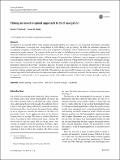Taking an insect-inspired approach to avian navigation
Date
03/2018Metadata
Show full item recordAbstract
Navigation is an essential skill for many animals, and understanding how animal use environmental information, particularly visual information, to navigate has a long history in both ethology and psychology. In birds, the dominant approach for investigating navigation at small-scales comes from comparative psychology, which emphasizes the cognitive representations underpinning spatial memory. The majority of this work is based in the laboratory and it is unclear whether this context itself affects the information that birds learn and use when they search for a location. Data from hummingbirds suggests that birds in the wild might use visual information in quite a different manner. To reconcile these differences, here we propose a new approach to avian navigation, inspired by the sensory-driven study of navigation in insects. Using methods devised for studying the navigation of insects, it is possible to quantify the visual information available to navigating birds, and then to determine how this information influences those birds’ navigation decisions. Focusing on four areas that we consider characteristic of the insect navigation perspective, we discuss how this approach has shone light on the information insects use to navigate, and assess the prospects of taking a similar approach with birds. Although birds and insects differ in many ways, there is nothing in the insect-inspired approach of the kind we describe that means these methods need be restricted to insects. On the contrary, adopting such an approach could provide a fresh perspective on the well-studied question of how birds navigate through a variety of environments.
Citation
Pritchard , D J & Healy , S D 2018 , ' Taking an insect-inspired approach to avian navigation ' , Learning and Behavior , vol. 46 , no. 1 , pp. 7-22 . https://doi.org/10.3758/s13420-018-0314-5
Publication
Learning and Behavior
Status
Peer reviewed
ISSN
1543-4494Type
Journal item
Collections
Items in the St Andrews Research Repository are protected by copyright, with all rights reserved, unless otherwise indicated.

